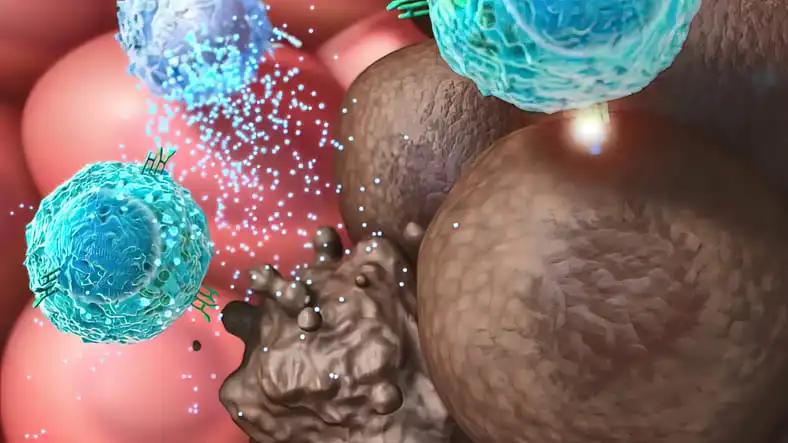KEY TAKEAWAYS
- The phase 1 trial aimed to investigate the efficacy and safety of AVA6000 in patients with FAP-positive solid tumors, focusing on targeted delivery and therapeutic outcomes.
- Researchers noticed significant antitumor activity in FAP-positive tumors due to high doxorubicin concentrations in the TME, which supports AVA6000 efficacy.
AVA6000 is a peptide drug conjugate designed for targeted delivery of doxorubicin to solid tumors with high fibroblast activation protein (FAP) activity in the tumor microenvironment (TME). FAP, overexpressed in many solid tumors, cleaves the peptide moiety of AVA6000, releasing doxorubicin specifically within the TME. The peptide moiety linker, Pre|CISIONTM, prevents cellular entry of doxorubicin until cleaved by FAP, enhancing tumor specificity.
U. Banerji and the team aimed to assess the efficacy and safety of AVA6000 in FAP-positive solid tumors. Preliminary results indicated promising antitumor activity and support ongoing dose escalation studies to further evaluate its potential in clinical settings.
They performed an inclusive analysis of the safety, pharmacokinetics (PK), and preliminary efficacy of AVA6000 in a first-in-man, multicenter dose-escalation phase I trial. AVA6000 was administered intravenously every 3 weeks using a standard 3+3 design in patients with locally advanced or metastatic solid tumors reported to be FAP-positive. PK-based dosing, utilizing area under the curve (AUC), was implemented to calculate maximum cycles of AVA6000, with a cumulative limit of 550 mg/m2.
About 40 patients (median age 65 years, range 30-79) receiving a median of 3 prior lines of therapy (range 0-7) were administered escalating doses of AVA6000 in a multicenter dose-escalation phase I trial. The doses ranged from 80 mg/m2 (equivalent to 51 mg/m2 of doxorubicin) to 385 mg/m2 (equivalent to 260 mg/m2 of doxorubicin). Patients presented with various tumor types, including soft tissue sarcoma (30%), colorectal cancer (27.5%), pancreatic cancer (20%), and cancers of the biliary tract (7.5%).
Overall, the safety profile of AVA6000 was favorable, with the most frequent adverse events (any grade) reported as fatigue (50%), alopecia (42.5%), and nausea (32.5%). Grade 3-4 hematologic toxicities were infrequent, with neutropenia, anemia, thrombocytopenia, and decreased white blood cell (WBC) count occurring in 5% of patients. Grade 3 non-hematologic toxicities included mucositis, fatigue, and hematemesis, each observed in 1 patient.
Two dose-limiting toxicities were reported, which were one case of grade 2 cardiac failure at a dose of 120 mg/m2 (with a decrease in left ventricular ejection fraction from 61 to 39%) and one case of grade 4 neutropenia/thrombocytopenia at a dose of 200 mg/m2. AVA6000 exhibited rapid distribution, with a half-life of 45 minutes. The maximum concentration (Cmax) of released doxorubicin was reduced compared to standard dose doxorubicin across dose cohorts, with a range of 78-93% reduction.
Tumor biopsy data demonstrated a mean concentration of doxorubicin in the TME of 860 ng/gm (range 76-2310 ng/gm, n=9). In contrast, blood samples collected at the biopsy showed a circulating free doxorubicin concentration of 8.3 ng/ml (range 2.4-15.9), indicating a higher concentration of doxorubicin in the tumor relative to plasma.
Using RECISTv.1.1 criteria, 1 patient achieved a partial response (-65%) lasting 6 months in undifferentiated pleomorphic sarcoma at a dose of 160 mg/m2, and another patient exhibited a mixed response (SLD -22%) in angiosarcoma at a dose of 200 mg/m2. The disease control rate at 12 weeks was 50%, with SD>4 months or partial response observed in 6 patients. Notably, high FAP enzyme activity in on-study tumor biopsies correlated with stable disease or partial response in these cases.
The study concluded that AVA6000 effectively delivers a high concentration of doxorubicin to the TME relative to plasma, leading to significant antitumor activity in tumors with high FAP activity. Ongoing dose escalation arms every 2 weeks (q2w) further investigate its potential.
The trial was sponsored by Avacta Life Sciences Ltd.
Source: https://www.abstractsonline.com/pp8/#!/20272/presentation/11478
Clinical Trial: https://clinicaltrials.gov/study/NCT04969835
Banerji U., Cook N., Anthoney A., et al. (2024). “A Phase I trial of AVA6000, a Fibroblast Activation Protein (FAP)-released and tumor microenvironment (TME)-targeted doxorubicin peptide drug conjugate in patients with FAP-positive solid tumors.” Presented at AACR 2024 (Abstract CT188 / 16).



